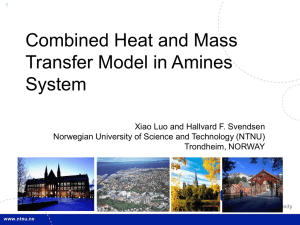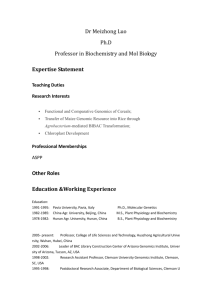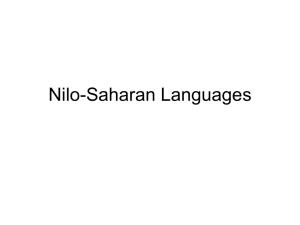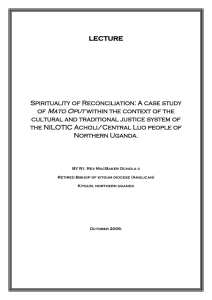Interference cancellation in a two-path relay system
advertisement
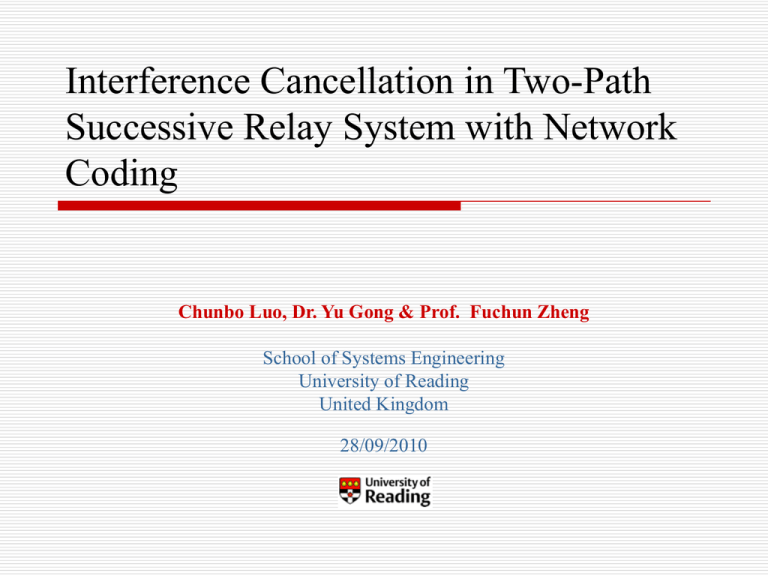
Interference Cancellation in Two-Path Successive Relay System with Network Coding Chunbo Luo, Dr. Yu Gong & Prof. Fuchun Zheng School of Systems Engineering University of Reading United Kingdom 28/09/2010 Contents Introduction and System Model Physical-layer Network Coding Interference Cancellation Simulation Results Conclusion and Future Work c.luo@reading.ac.uk Introduction Cooperative networks •Demands in wireless communications: Higher data rate Higher spectrum efficiency Reliable connections Lower energy consumption Longer battery life … •Dilemma: Limited resource <-> Unlimited requirements •Solutions? Cooperative networks c.luo@reading.ac.uk Introduction Cooperative networks WHY and HOW? Please see one of the cooperative models: two- Path cooperative model RELAY Source: S Relays: R Destination: D c.luo@reading.ac.uk Introduction Cooperative networks Large and better coverage Lower transmission energy More reliable connection …… There are loads of benefits. But…. The Limit of half-duplex transmission c.luo@reading.ac.uk Introduction Cooperative networks Solution? R1 and R2 alternatively relay the data from S to D. At the relay: At the destination: c.luo@reading.ac.uk Introduction Cooperative networks But… INTER RELAY INTERFERENCE (IRI) c.luo@reading.ac.uk IRI Cancellation Inter relay interference (IRI) Solution • Interference cancellation schemes • Our scheme: Physical Network Coding (PNC) What is PNC? Why can PNC solve the problem? How does it work? c.luo@reading.ac.uk IRI Cancellation Why and how does PNC work to reduce IRI? To clearly show the basic mechanism: we use the following ideal model: Ideal environment: no noise, channels are stable (no fading) R receives: Then R performs PNC. At n+1 time slot, R transmits the PNC result. D receives: c.luo@reading.ac.uk IRI Cancellation Why and how does PNC work to reduce IRI? At destination, we do another XOR: IRI is totally removed!!! c.luo@reading.ac.uk IRI Cancellation Why and how does PNC work to reduce IRI? The actual received signal at R is: How does PNC work? Key: c.luo@reading.ac.uk Physical-layer Network Coding PNC Example-BPSK If BPSK used, we have: A: -1, 1 B: -1, 1 So relay received patterns: -2 0 2, using the following equation: 1-0.5*(Magnitude of received signal): 1: A and B are different 0: A and B are the same 1 Mapping to 1 0 Mapping to -1 XOR! c.luo@reading.ac.uk Physical-layer Network Coding XOR in Physical layer: By using certain equations, we have: Y=A B XOR in Physical layer c.luo@reading.ac.uk Physical-layer Network Coding XOR in Physical layer: But…. How about other modulation schemes? e.g. QPSK See the table below (It can be found in the paper) c.luo@reading.ac.uk IRI Cancellation XOR in Physical layer: But…. How about in practical systems? The transmissions suffer from channel fading and additive noises. The system model c.luo@reading.ac.uk IRI Cancellation In practical system 1) MAP Detection at relays: 2) Joint detection and PNC: 3) Relay transmission c.luo@reading.ac.uk IRI Cancellation In practical situation: 4) MAP Detection at destination: 5) PNC decoding: where is the result we want! c.luo@reading.ac.uk Simulation results Gaussian model: c.luo@reading.ac.uk Simulation results Rayleigh model: c.luo@reading.ac.uk Conclusion and future work The proposed PNC interference cancellation scheme can effectively reduce IRI Its performance depends on the accuracy of channel estimation (MAP detection) PNC can be used in signal processing areas to deal with interference problems c.luo@reading.ac.uk Conclusion and future work The scenario with direct link available The joint coding and detection Multi-source multi relay scenario The complexity of MAP detection c.luo@reading.ac.uk Interference Cancellation in Two-Path Successive Relay System with Network Coding Thank you! c.luo@reading.ac.uk

